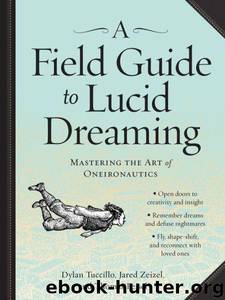A Field Guide to Lucid Dreaming by Dylan Tuccillo & Jared Zeizel & Thomas Peisel

Author:Dylan Tuccillo & Jared Zeizel & Thomas Peisel [Tuccillo, Dylan & Zeizel, Jared & Peisel, Thomas]
Language: eng
Format: epub
ISBN: 9780761177395
Amazon: 0761177396
Publisher: Workman Publishing Company
Published: 2013-09-10T04:00:00+00:00
3. Find them at a hot spot. Try looking for them where they’re
usually found, whether it’s your old house, a local bakery he fre-
quented, or the factory where he worked. Make it easier on your
left brain by providing a familiar stage to set your play. Use door-
ways, other rooms, close your eyes, anything to trick your mind
into believing that you’ll find this person nearby.
Creating Works of Art
In the physical world, art
has always existed as a
hastily I make a chamber in the mesa cliff,
way of expressing the inner
with a hidden airhole too small for a per-
workings of the human
son to squeeze in or out. I add a “chimney”
spirit. It’s only limits are
hole on top so the air will circulate, and
that of the creator’s imagi-
then teleport myself inside. I adjust the
nation and the physical
stone like punching a pillow. —chrIS W.
laws of the waking world.
But can’t we start up an
art project in our dreams? Besides its role as an amazing creative
outlet, creating art while lucid dreaming has some “practical” ben-
efits: some works of art can take months even years to create in
the waking world, but not in the dream state. You can build a
huge, complicated work in mere moments. Lucid dreaming also
allows you to experiment with art that could not be physically con-
structed on the planet Earth. For example, if you’re an architect,
don’t wait for that funding to come through—build your dream
building!
= 147 <
1. Intention. Wake up before your last REM cycle. Slap yourself on the cheeks, some cold water might help. Now, think about the art
that you want to create. After deciding upon your creation, go to
sleep with the intention of making it.
2. The right tools for the job. Because your stubborn brain is still somewhat tied to the physical world, it will be helpful to use the
proper tools that you’re used to working with. Once you are lucid,
seek out your materials or create them. If you are painting some-
thing in the dream space, use paint and a brush on canvas. As time
goes on, you’ll find that you won’t need paint tubes. Eventually,
brushes will also become obsolete and you’ll be able to paint with
only your mind.
3. Thinking outside the frame. Part of being an artist and a lucid dreamer is trying out new things. The dream world is at your fin-gertips, so why paint on just canvas? Try painting a building. Hell,
trying painting an entire planet! Don’t just sculpt a statue, sculpt
a civilization. If you like movies, create one that you can walk
around in. Write a song and ask a sycamore tree to sing it for you.
In the dream world, the only limitation to art is your imagination
and your own concepts of what’s possible.
Thinking Big
Once you’ve mastered the basics, you can create things of
higher complexity and with more ease. You won’t need the
comfort blanket of waking-world logic as you effortlessly manifest
= 148 <
Download
This site does not store any files on its server. We only index and link to content provided by other sites. Please contact the content providers to delete copyright contents if any and email us, we'll remove relevant links or contents immediately.
Man and His Symbols by Carl Gustav Jung(4017)
Angel Dreams by Virtue Doreen Virtue Melissa(1422)
God's Prophetic Symbolism in Everyday Life by Adam Thompson & Adrian Beale(1413)
[2004] Mass Psychology (Penguin Modern Classics) by Sigmund Freud(1393)
The Pizza Party by Theo Baker(1386)
Forgotten Language by Erich Fromm(1232)
Dreams by C. G. Jung(1230)
Conscious Dreaming: A Spiritual Path for Everyday Life by Robert Moss(1208)
Inner Work by Johnson Robert A(1208)
Mass Psychology (Penguin Modern Classics) by Sigmund Freud(1207)
American Dreams by Unknown(1201)
12,000 Dreams Interpreted by Linda Shields(1198)
Be Wise Now by Gael McCool(1178)
The Art Of Dreaming by Carlos Castaneda(1168)
Inner Work Using Dreams & Active Imagination For Personal Growth - Robert A. Johnson by Robert A. Johnson(1144)
Chicken Soup for the Soul by Amy Newmark & Kelly Sullivan Walden(1131)
The Pagan Dream of the Renaissance by Joscelyn Godwin(1104)
Leopard Warrior by John Lockley(1065)
Conscious Dreaming by Robert Moss(1058)
